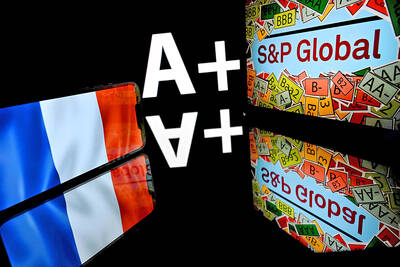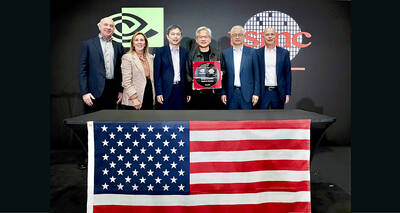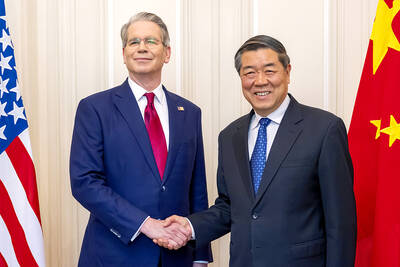Casetek Holdings Ltd (鎧勝), a metal casing supplier for Apple Inc’s iPads and MacBooks, yesterday reported a 50 percent annual decline in net profit to NT$1.08 billion (US$34.36 million) for last quarter, dragged down by falling global demand for tablets.
This brought the company’s cumulative net profit to NT$2.8 billion, or NT$8.26 per share, half of the NT$5.63 billion, or NT$16.59 per share, it made in the previous year, the company’s data showed.
“The declining global demand for tablets and a client’s delayed launch of its new notebook computers affected Casetek’s performance on both revenues and profit last year,” chief financial officer Jonathan Chang (張昭平) told an investors conference at the company’s headquarters in Taipei.
Casetek, which is a subsidiary of iPhone assembler Pegatron Corp (和碩), saw its gross margin fall by 6.2 percentage points to 19.3 percent last year, while its operating margin contracted by 6.4 percentage points annually to 10.2 percent, the data showed.
Casetek chairman Jason Cheng (程建中), who doubles as Pegatron’s vice chairman, said the casing company’s performance last year was “below industry levels,” but he plans to maintain a similar dividend policy and payout ratio to last year’s 48.2 percent.
That would translate into a cash dividend of NT$3.98 based on the firm’s earnings per share of NT$8.26 last year, compared with the cash dividend of NT$8 a year ago.
The proposal is pending the board of directors’ approval.
Citing the company’s revenue pattern, Cheng said the company estimates that revenue this quarter could fall as much as 30 percent from last quarter’s NT$10.29 billion due to the beginning of an annual slow season for consumer electronics products.
In an effort to improve the company’s profitability this year, Cheng said Casetek will only take orders that have higher margins and average selling prices.
Cheng said Casetek is stepping up measures to increase the number of its clients and products to offset the effects of the declining tablet industry, efforts he said will pay off in the second half of this year.
The company has secured orders from four smartphone clients and will gradually begin shipments from the end of next quarter, Cheng added.
The clients include one of the top five Chinese smartphone vendors that sells “tens of millions” of handsets per year, according to Casetek chief executive officer Gary Chuang (莊育志).

France cannot afford to ignore the third credit-rating reduction in less than a year, French Minister of Finance Roland Lescure said. “Three agencies have downgraded us and we can’t ignore this cloud,” he told Franceinfo on Saturday, speaking just hours after S&P lowered his country’s credit rating to “A+” from “AA-” in an unscheduled move. “Fundamentally, it’s an additional cloud to a weather forecast that was already pretty gray. It’s a call for lucidity and responsibility,” he said, adding that this is “a call to be serious.” The credit assessor’s move means France has lost its double-A rating at two of the

Jensen Huang (黃仁勳), founder and CEO of US-based artificial intelligence chip designer Nvidia Corp and Taiwan Semiconductor Manufacturing Co (TSMC, 台積電) on Friday celebrated the first Nvidia Blackwell wafer produced on US soil. Huang visited TSMC’s advanced wafer fab in the US state of Arizona and joined the Taiwanese chipmaker’s executives to witness the efforts to “build the infrastructure that powers the world’s AI factories, right here in America,” Nvidia said in a statement. At the event, Huang joined Y.L. Wang (王英郎), vice president of operations at TSMC, in signing their names on the Blackwell wafer to

AI BOOST: Although Taiwan’s reliance on Chinese rare earth elements is limited, it could face indirect impacts from supply issues and price volatility, an economist said DBS Bank Ltd (星展銀行) has sharply raised its forecast for Taiwan’s economic growth this year to 5.6 percent, citing stronger-than-expected exports and investment linked to artificial intelligence (AI), as it said that the current momentum could peak soon. The acceleration of the global AI race has fueled a surge in Taiwan’s AI-related capital spending and exports of information and communications technology (ICT) products, which have been key drivers of growth this year. “We have revised our GDP forecast for Taiwan upward to 5.6 percent from 4 percent, an upgrade that mainly reflects stronger-than-expected AI-related exports and investment in the third

RARE EARTHS: The call between the US Treasury Secretary and his Chinese counterpart came as Washington sought to rally G7 partners in response to China’s export controls China and the US on Saturday agreed to conduct another round of trade negotiations in the coming week, as the world’s two biggest economies seek to avoid another damaging tit-for-tat tariff battle. Beijing last week announced sweeping controls on the critical rare earths industry, prompting US President Donald Trump to threaten 100 percent tariffs on imports from China in retaliation. Trump had also threatened to cancel his expected meeting with Chinese President Xi Jinping (習近平) in South Korea later this month on the sidelines of the APEC summit. In the latest indication of efforts to resolve their dispute, Chinese state media reported that